Yao Tang
NoteBar: An AI-Assisted Note-Taking System for Personal Knowledge Management
Sep 03, 2025Abstract:Note-taking is a critical practice for capturing, organizing, and reflecting on information in both academic and professional settings. The recent success of large language models has accelerated the development of AI-assisted tools, yet existing solutions often struggle with efficiency. We present NoteBar, an AI-assisted note-taking tool that leverages persona information and efficient language models to automatically organize notes into multiple categories and better support user workflows. To support research and evaluation in this space, we further introduce a novel persona-conditioned dataset of 3,173 notes and 8,494 annotated concepts across 16 MBTI personas, offering both diversity and semantic richness for downstream tasks. Finally, we demonstrate that NoteBar can be deployed in a practical and cost-effective manner, enabling interactive use without reliance on heavy infrastructure. Together, NoteBar and its accompanying dataset provide a scalable and extensible foundation for advancing AI-assisted personal knowledge management.
Representation Entanglement for Generation:Training Diffusion Transformers Is Much Easier Than You Think
Jul 02, 2025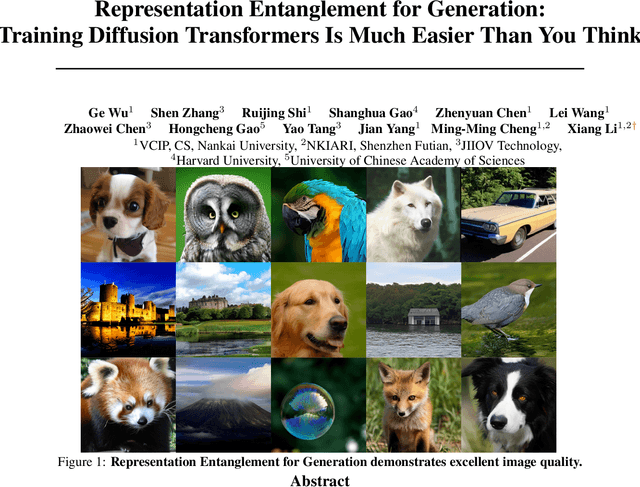
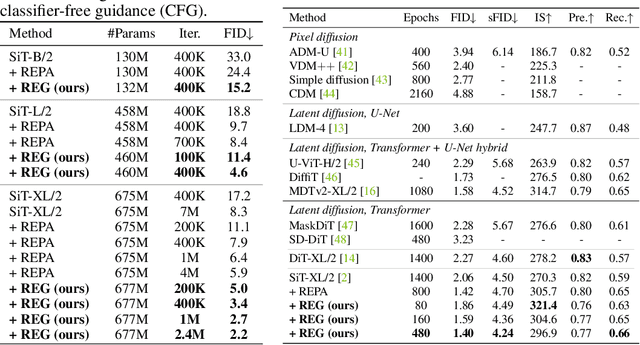
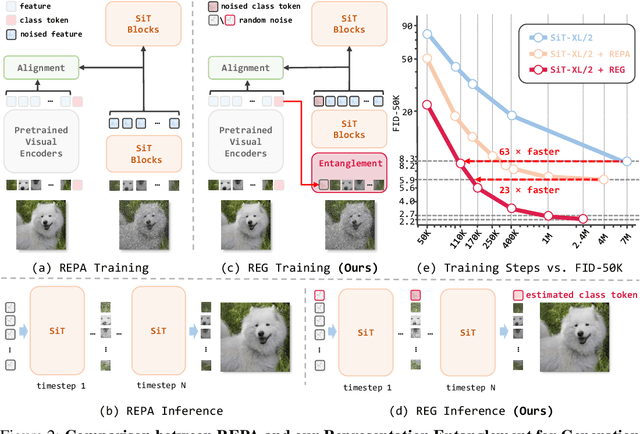
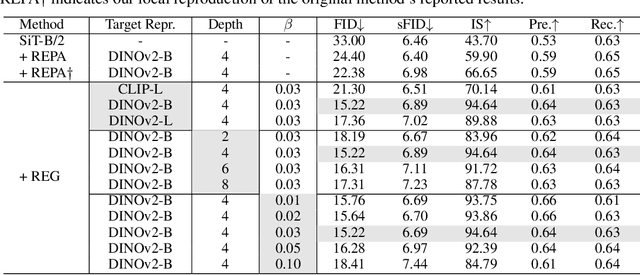
Abstract:REPA and its variants effectively mitigate training challenges in diffusion models by incorporating external visual representations from pretrained models, through alignment between the noisy hidden projections of denoising networks and foundational clean image representations. We argue that the external alignment, which is absent during the entire denoising inference process, falls short of fully harnessing the potential of discriminative representations. In this work, we propose a straightforward method called Representation Entanglement for Generation (REG), which entangles low-level image latents with a single high-level class token from pretrained foundation models for denoising. REG acquires the capability to produce coherent image-class pairs directly from pure noise, substantially improving both generation quality and training efficiency. This is accomplished with negligible additional inference overhead, requiring only one single additional token for denoising (<0.5\% increase in FLOPs and latency). The inference process concurrently reconstructs both image latents and their corresponding global semantics, where the acquired semantic knowledge actively guides and enhances the image generation process. On ImageNet 256$\times$256, SiT-XL/2 + REG demonstrates remarkable convergence acceleration, achieving $\textbf{63}\times$ and $\textbf{23}\times$ faster training than SiT-XL/2 and SiT-XL/2 + REPA, respectively. More impressively, SiT-L/2 + REG trained for merely 400K iterations outperforms SiT-XL/2 + REPA trained for 4M iterations ($\textbf{10}\times$ longer). Code is available at: https://github.com/Martinser/REG.
Reinforcement Pre-Training
Jun 09, 2025Abstract:In this work, we introduce Reinforcement Pre-Training (RPT) as a new scaling paradigm for large language models and reinforcement learning (RL). Specifically, we reframe next-token prediction as a reasoning task trained using RL, where it receives verifiable rewards for correctly predicting the next token for a given context. RPT offers a scalable method to leverage vast amounts of text data for general-purpose RL, rather than relying on domain-specific annotated answers. By incentivizing the capability of next-token reasoning, RPT significantly improves the language modeling accuracy of predicting the next tokens. Moreover, RPT provides a strong pre-trained foundation for further reinforcement fine-tuning. The scaling curves show that increased training compute consistently improves the next-token prediction accuracy. The results position RPT as an effective and promising scaling paradigm to advance language model pre-training.
LEDiT: Your Length-Extrapolatable Diffusion Transformer without Positional Encoding
Mar 07, 2025Abstract:Diffusion transformers(DiTs) struggle to generate images at resolutions higher than their training resolutions. The primary obstacle is that the explicit positional encodings(PE), such as RoPE, need extrapolation which degrades performance when the inference resolution differs from training. In this paper, we propose a Length-Extrapolatable Diffusion Transformer(LEDiT), a simple yet powerful architecture to overcome this limitation. LEDiT needs no explicit PEs, thereby avoiding extrapolation. The key innovations of LEDiT are introducing causal attention to implicitly impart global positional information to tokens, while enhancing locality to precisely distinguish adjacent tokens. Experiments on 256x256 and 512x512 ImageNet show that LEDiT can scale the inference resolution to 512x512 and 1024x1024, respectively, while achieving better image quality compared to current state-of-the-art length extrapolation methods(NTK-aware, YaRN). Moreover, LEDiT achieves strong extrapolation performance with just 100K steps of fine-tuning on a pretrained DiT, demonstrating its potential for integration into existing text-to-image DiTs. Project page: https://shenzhang2145.github.io/ledit/
QLASS: Boosting Language Agent Inference via Q-Guided Stepwise Search
Feb 04, 2025



Abstract:Language agents have become a promising solution to complex interactive tasks. One of the key ingredients to the success of language agents is the reward model on the trajectory of the agentic workflow, which provides valuable guidance during training or inference. However, due to the lack of annotations of intermediate interactions, most existing works use an outcome reward model to optimize policies across entire trajectories. This may lead to sub-optimal policies and hinder the overall performance. To address this, we propose QLASS (Q-guided Language Agent Stepwise Search), to automatically generate annotations by estimating Q-values in a stepwise manner for open language agents. By introducing a reasoning tree and performing process reward modeling, QLASS provides effective intermediate guidance for each step. With the stepwise guidance, we propose a Q-guided generation strategy to enable language agents to better adapt to long-term value, resulting in significant performance improvement during model inference on complex interactive agent tasks. Notably, even with almost half the annotated data, QLASS retains strong performance, demonstrating its efficiency in handling limited supervision. We also empirically demonstrate that QLASS can lead to more effective decision making through qualitative analysis. We will release our code and data.
Learning Versatile Skills with Curriculum Masking
Oct 23, 2024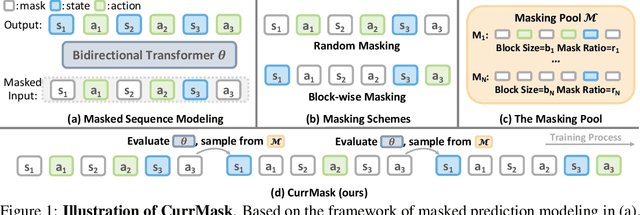



Abstract:Masked prediction has emerged as a promising pretraining paradigm in offline reinforcement learning (RL) due to its versatile masking schemes, enabling flexible inference across various downstream tasks with a unified model. Despite the versatility of masked prediction, it remains unclear how to balance the learning of skills at different levels of complexity. To address this, we propose CurrMask, a curriculum masking pretraining paradigm for sequential decision making. Motivated by how humans learn by organizing knowledge in a curriculum, CurrMask adjusts its masking scheme during pretraining for learning versatile skills. Through extensive experiments, we show that CurrMask exhibits superior zero-shot performance on skill prompting tasks, goal-conditioned planning tasks, and competitive finetuning performance on offline RL tasks. Additionally, our analysis of training dynamics reveals that CurrMask gradually acquires skills of varying complexity by dynamically adjusting its masking scheme.
Solution of Multiview Egocentric Hand Tracking Challenge ECCV2024
Sep 28, 2024


Abstract:Multi-view egocentric hand tracking is a challenging task and plays a critical role in VR interaction. In this report, we present a method that uses multi-view input images and camera extrinsic parameters to estimate both hand shape and pose. To reduce overfitting to the camera layout, we apply crop jittering and extrinsic parameter noise augmentation. Additionally, we propose an offline neural smoothing post-processing method to further improve the accuracy of hand position and pose. Our method achieves 13.92mm MPJPE on the Umetrack dataset and 21.66mm MPJPE on the HOT3D dataset.
FMPAF: How Do Fed Chairs Affect the Financial Market? A Fine-grained Monetary Policy Analysis Framework on Their Language
Mar 10, 2024Abstract:The effectiveness of central bank communication is a crucial aspect of monetary policy transmission. While recent research has examined the influence of policy communication by the chairs of the Federal Reserve on various financial variables, much of the literature relies on rule-based or dictionary-based methods in parsing the language of the chairs, leaving nuanced information about policy stance contained in nonverbal emotion out of the analysis. In the current study, we propose the Fine-Grained Monetary Policy Analysis Framework (FMPAF), a novel approach that integrates large language models (LLMs) with regression analysis to provide a comprehensive analysis of the impact of the press-conference communications of chairs of the Federal Reserve on financial markets. We conduct extensive comparisons of model performance under different levels of granularity, modalities, and communication scenarios. Based on our preferred specification, a one-unit increase in the sentiment score is associated with an increase of the price of S\&P 500 Exchange-Traded Fund by approximately 500 basis points, a 15-basis-point decrease in the policy interest rate, while not leading to a significant response in exchange rates.
A Simple Baseline for Efficient Hand Mesh Reconstruction
Mar 04, 2024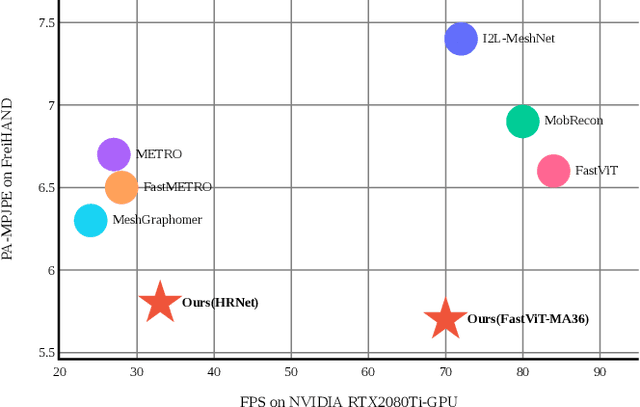
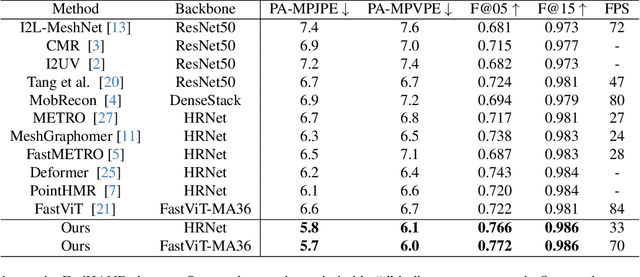
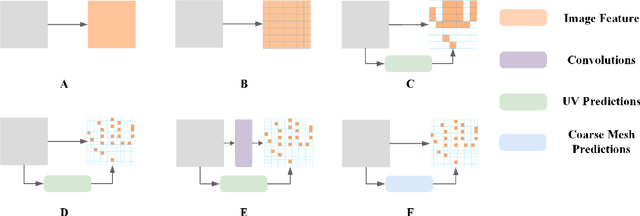

Abstract:3D hand pose estimation has found broad application in areas such as gesture recognition and human-machine interaction tasks. As performance improves, the complexity of the systems also increases, which can limit the comparative analysis and practical implementation of these methods. In this paper, we propose a simple yet effective baseline that not only surpasses state-of-the-art (SOTA) methods but also demonstrates computational efficiency. To establish this baseline, we abstract existing work into two components: a token generator and a mesh regressor, and then examine their core structures. A core structure, in this context, is one that fulfills intrinsic functions, brings about significant improvements, and achieves excellent performance without unnecessary complexities. Our proposed approach is decoupled from any modifications to the backbone, making it adaptable to any modern models. Our method outperforms existing solutions, achieving state-of-the-art (SOTA) results across multiple datasets. On the FreiHAND dataset, our approach produced a PA-MPJPE of 5.7mm and a PA-MPVPE of 6.0mm. Similarly, on the Dexycb dataset, we observed a PA-MPJPE of 5.5mm and a PA-MPVPE of 5.0mm. As for performance speed, our method reached up to 33 frames per second (fps) when using HRNet and up to 70 fps when employing FastViT-MA36
FAAC: Facial Animation Generation with Anchor Frame and Conditional Control for Superior Fidelity and Editability
Dec 20, 2023



Abstract:Over recent years, diffusion models have facilitated significant advancements in video generation. Yet, the creation of face-related videos still confronts issues such as low facial fidelity, lack of frame consistency, limited editability and uncontrollable human poses. To address these challenges, we introduce a facial animation generation method that enhances both face identity fidelity and editing capabilities while ensuring frame consistency. This approach incorporates the concept of an anchor frame to counteract the degradation of generative ability in original text-to-image models when incorporating a motion module. We propose two strategies towards this objective: training-free and training-based anchor frame methods. Our method's efficacy has been validated on multiple representative DreamBooth and LoRA models, delivering substantial improvements over the original outcomes in terms of facial fidelity, text-to-image editability, and video motion. Moreover, we introduce conditional control using a 3D parametric face model to capture accurate facial movements and expressions. This solution augments the creative possibilities for facial animation generation through the integration of multiple control signals. For additional samples, please visit https://paper-faac.github.io/.
 Add to Chrome
Add to Chrome Add to Firefox
Add to Firefox Add to Edge
Add to Edge